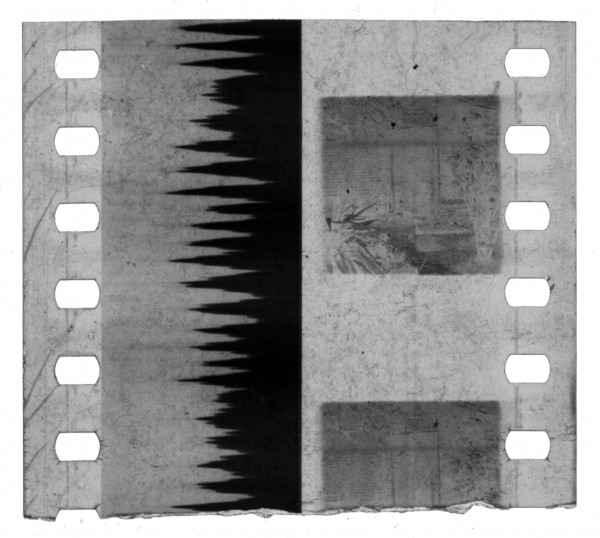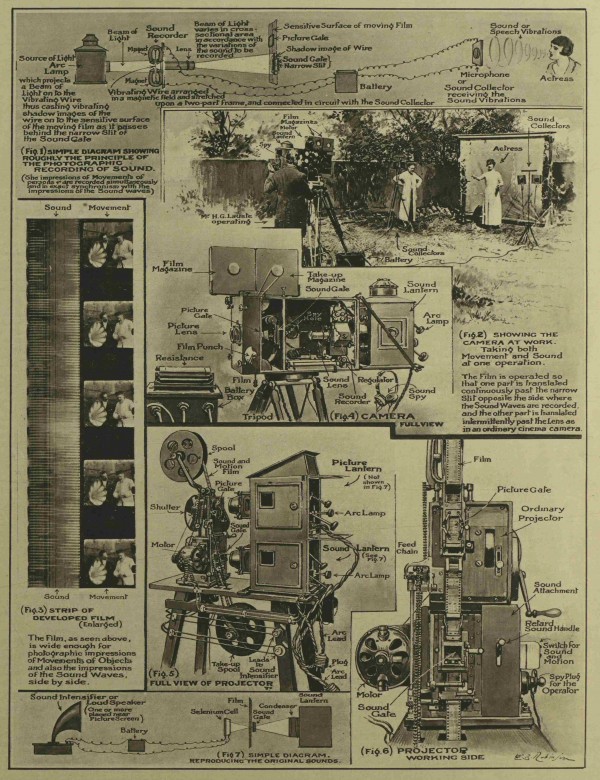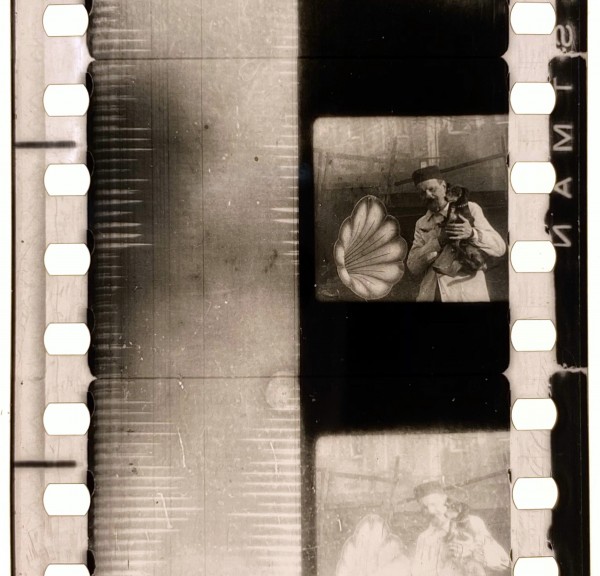A series of interrelated experiments using both variable-density and variable-area to create some of the first sound-on-film with synchronized picture recordings.
Film Explorer

A test made by Eugène Lauste in 1911/12. This 35mm negative features a wide variable-area soundtrack on the left and a small picture frame on the right, recorded in synchronization.
Film Frame Collection, Seaver Center for Western History Research, Natural History Museum of Los Angeles County, Los Angeles, CA, United States.

A test made by Eugène Lauste in 1911/12, employing a string galvanometer that used two diametric wires of silicon bronze acting between the poles of two strong magnets. A longer fragment of this test survives at the George Eastman Museum in Rochester, NY.
Film Frame Collection, Seaver Center for Western History Research, Natural History Museum of Los Angeles County, Los Angeles, CA, United States.
Identification
B/W, orthochromatic.
None
1
A large variable-area, or variable-density track that filled the left half of the 35mm film strip (inside the perforations), ranging in width from approximately 12.19mm to 12.58mm (0.48 in to 0.5 in), synchronized to a small portrait-oriented image on the right-hand side, photographed simultaneously.
One loudspeaker for playback. Lauste used microphone relays for amplification.
Surviving film samples vary between approximately 11.18mm x 11.42mm (0.44 in x 0.45 in) and 12.19mm x 15.64mm (0.48 in x 0.62 in).The soundtrack takes up the other half of the frame.
Believed to be similar to Bell & Howell (BH) negative type.
B/W, orthochromatic.
None
History
Eugène Augustin Lauste (1857–1935) worked, from the early 1900s to the end of his life, on a series of experiments using both variable-area and variable-density to create some of the first sound-on-film with synchronized picture recordings.
Lauste claims that he first had the idea to record sound photographically in 1888, after reading an account in the Scientific American Supplement (May 21, 1881) of the invention of the Photophone by Alexander Graham Bell and Sumner Tainter. Lauste’s reasoning was that “if sound could be transmitted through space by means of radiant energy these electrical sound waves could also be recorded photographically and reproduced, using the selenium cell in the same manner as Dr. Bell had used it.” (Crawford, 1932) The French-born Lauste was at that time working as an electrician for Edison in New Jersey and claims that he kept his experiments secret for fear of being ridiculed, which makes it difficult to verify his statement.
It seems that Lauste devoted an increasing amount of time to his experimentations in sound recording from 1900 onwards, after having successfully worked for Edison and the Lathams and, subsequently, with William Kennedy Laurie Dickson at the British and French Mutoscope & Biograph companies in London and Paris. From 1903, Lauste worked as an independent engineer and inventor, first from W. K. L. Dickson’s research laboratory in London, then setting up his own laboratory in Brixton, South London, supported by a succession of investors (Spehr, 1999). In 1905, Lauste secured his first investment and filed an application with the British Patent Office in 1906, which was granted to him in 1907. The patent, titled “A new and improved Method of and Means for Simultaneously Recording and Reproducing Movements and Sounds”, records Lauste and his financial backers, Robert Haines (an Australian contact of Dickson) and a British engineer John St. Vincent Pletts, as the inventors. Lauste, however, later claimed that he was the sole inventor.
1908 was an important year for Lauste, as he moved from Dickson’s laboratory to set up his own in Brixton, secured investments from Mr. George W. Jones, then general manager of the London Cinematograph Company – and visited German engineer Ernst Ruhmer in Berlin for the first time, with whom he had entertained a long correspondence. He returned to London with Ruhmer’s Photographophone and acquired an alternative selenium cell, manufactured by Bidwell in England, to study. Interestingly, both Lauste and Ruhmer were convinced that the other’s invention would never work for motion pictures. Lauste thought that Ruhmer’s ‘singing arc’ was not suitable for recording talking pictures, while Ruhmer thought that Lauste’s mechanical-grate light valves couldn’t work – the induced vibrations being too slow to record sound accurately (Crawford 1932).
By 1910 Lauste had almost abandoned his experiments, but then had the idea of experimenting with a string galvanometer in the building of an electro diamagnetic recorder. The exact chronology of Lauste’s inventions from 1910 to 1913 is difficult to establish, but it seems that these were his most successful years and he was able to secure new investment to develop his Sound and Scene camera, thanks to the diamagnetic method. By 1913, Lauste’s system was working to his satisfaction, and he now set his sights on solving his last issue – finding an adequate sound-amplification system, the only way to make his technology commercially viable. Unfortunately, the arrival of World War I in Europe put a stop to his experiments. The Lauste family moved to the United States in 1916, where he was hoping to secure new investors, but he was ultimately not successful.
Between 1920 and 1930, Lauste met Merrit Crawford and Francis Doublier in New Jersey who, he discovered, shared his passion for film history and technology. Lauste was, by then, then running a boarding house in Bloomfield, New Jersey. Merrit Crawford published several articles on Lauste’s work and pushed Bell Laboratories to purchase Lauste’s technologies, patents and apparatus (which he partially reconstructed for preservation). Bell later donated the Lauste collection to the Smithsonian. Francis Doublier recorded several home movies with Lauste, his wife Méline Lauste, Louise Doublier and Merrit Crawford, shortly before Lauste’s death in 1935. Seemingly, Lauste also entrusted Doublier with some of his test films, which are now held as part of the Francis Doublier collection at the George Eastman Museum, Rochester, NY (Auclair, 2023). A preservation of these experiments, in addition to closer study of Lauste’s apparatus preserved at the Smithonian, could teach us more about the technological breakthroughs Lauste achieved that contributed so much to the invention of sound cinema.
Technology
Eugène Lauste’s first goal, in the late 1880s, was to record sound vibrations photographically on sensitized bromide paper, hoping to find a way to direct and reproduce them using mirrors and reflected light. But paper was not sensitive enough. The introduction of Eastman’s sensitized celluloid transparent roll film in 1889 provided him with a new ideal support medium for his experimentations. According to historian Merritt Crawford, it’s likely that Lauste created his first grate light valve – an apparatus used to record a variable-density soundtrack – around 1900. At the time, he was working, along with William Kennedy Laurie Dickson, for the British Mutoscope & Biograph Company in Paris.
Lauste’s first sound recording apparatus, built around 1900, under the sponsorship of Dickson, was a simple box with a slit opening, behind which the film passed. A crank advanced the film behind the slit and a system made from a diaphragm fitted with mirrors reflected light on to the slit in response to sound waves. This technology was identical to a previous technology developed by Alexander Graham Bell and Clarence J. Blake in 1874 except that Lauste used film in place of a photographic plate (Everett, 2019). Lauste described this apparatus as “a little more than a toy”, created only to prove to Dickson that sound could be recorded (Crawford, 1932). Until 1905, Lauste kept experimenting with different recording systems, building grate light valves and introducing selenium cells.
In 1905, Lauste built his first patented apparatus able to record and playback sound and image on the same strip of film. Sound waves were recorded in variable density and the results were not very successful, but he was nevertheless able to obtain a patent for his invention with the British Patent office, co-signed with his financial backers John St Vincent Pletts and Robert Haines.
From 1908, Lauste built a different recording system producing either variable-density, or variable-area, soundtracks. He experimented with many different ways to record sound: a magnetic system, in which a magnetic keeper allowed for a spool to move within the magnetic field; several systems that involved intercepting the light source; and, subsequently, he experimented a lot with emerging telephone technologies.
Lauste simultaneously developed two devices that were both successful at recording sound, from 1910. One apparatus was close in concept to a light-valve later developed by Western Electric: a device consisting of a loop of diamagnetic metal wire placed in a magnetic field, the two branches of the loop vibrating under the influence of modulated electric currents. It was with this device that he was able to record both sound and image on the same strip of film – a technique which he perfected between 1910 and 1913. Lauste continually improved this invention, experimenting with double- and single-vibrating wires, and wire damping to absorb secondary vibrations. He patented all his modifications in both France and England, under his own name, in 1912 and 1913. Before World War I broke out, Lauste’s Sound and Scene technology couldn’t be successfully commercialized, as he was unable to achieve sufficient playback volume for the system to be used in movie theaters.

Series of diagrams illustrating Lauste’s Sound and Scene camera and projectors.
Robinson, W. B. (1920). “Speaking Movies: Synchronising Sound and Picture”. Illustrated London News (January 10, 1920): p. 45.

Duplicate of a Lauste Sound and Scene experiment, with the variable-density soundtrack (left) and the image (right) recorded simultaneously. Original experiments dated 1911–1912. 35mm nitrate print, c. 1935.
George Eastman Museum, Rochester, NY, United States.
References
Allen, Bob (1997). “Eugene Lauste. Father of Sound on Film”. The Newsletter of the Association of Motion Picture Sound, 22:1 (Summer): pp. 8–10.
Auclair, Clara (2023). Collected Memory: Histories of the French Film Industry in Fort Lee, NJ. PhD dissertation, University of Rochester/Université Paris Cité.
Browning, Irving (1945). “Eugene Augustin Lauste. Inventor – Sound Movies”. American Cinematographer, 26:1 (January): p. 10.
Crawford, Merritt (1932). “Pioneer Experiments of Eugene Lauste in Recording Sound”. Journal of the Society of Motion Pictures Engineer, 19:4 (October): pp. 632–644.
Everett, Tom (2019). “Writing sound with a human ear: reconstructing Bell and Blake’s 1874 ear phonautograph”. Science Museum Group Journal, 12 (Autumn). https://dx.doi.org/10.15180/191206/001
Eyman, Scott (1997). The Speed of Sound: Hollywood and the Talkie Revolution 1926–1930. New York: Simon & Schuster.
Hiller, John (1999). “Eugene Augustin Lauste; Apparatus in the Smithsonian Institution, National Museum of American History, Photographic Collection”. Film History, 11:1: pp. 39–44.
Singer, R. (1932). “Les travaux d’Eugène Lauste”. La Technique Cinématographique,12:1: pp. 532–536.
Spehr, Paul C. (1999). “Eugene Augustin Lauste: A biographical chronology”. Film History,11:1: pp. 18–36.
Patents
Haines, Robert Thorn, John St. Vincent Pletts & Eugène Augustin Lauste. 1906. A New or Improved Method of Means for Simultaneously Recording and Reproducing Movements and Sounds. British Patent GB 190618057 (A), filed Aug. 11, 1906 and issued Aug. 10, 1907.
Lauste, Eugène Augustin. 1913. Improvements in and relating to Sound Recording and Reproducing Devices and the like. British Patent GB 191210526 (A), filed May 3, 1912 and issued Aug. 5, 1913.
Lauste, Eugène Augustin. 1913. Improvements in and relating to Apparatus for use in the Photographic Recording of Sound. British patent GB 191316942 (A), filed Nov. 4, 1912 and issued Nov. 4, 1913.
Lauste, Eugène Augustin. 1913. Improvements in Apparatus for the Reproduction of a Combined Photographic Record of Movement and Sound. British Patent GB191316941 (A), filed Nov. 4, 1912 and issued Nov. 4, 1913.
Lauste, Eugène Augustin. 1913. Perfectionnements aux dispositifs pour enregistrer, simultanément, par la photographie, les mouvements et les sons, et pour en assurer la reproduction. French patent FR457412 (A), filed May 3, 1913 and issued Sep. 17, 1913.
Compare
Related entries
Author
Clara Auclair is a film scholar and preservationist based in Stockholm, Sweden. Clara earned her doctorate from the University of Rochester, NY, and Université Paris Cité and is a graduate from the L. Jeffrey Selznick School of Film Preservation. She has been a guest researcher at Cinémathèque française in Paris and at the George Eastman Museum in Rochester, NY. Clara’s current research focuses on film workers mobilities at the beginning of the twentieth century and reflects on the provenance of archival collections, the tensions governing family and institutional archives, and the writing of history in film studies. She currently teaches media studies in Stockholm, Sweden. Clara has been a member of the executive committee of Domitor, the international association for early film research, since 2016, and its secretary since 2019.
Peter Bagrov, Anthony L’Abbate, Gordon Nelson, Sophia Lorent, Nancy Kauffman, Deborah Stoiber, Joshua Romphf.
Auclair, Clara (2024). “Lauste Sound and Scene”. In James Layton (ed.), Film Atlas. www.filmatlas.com. Brussels: International Federation of Film Archives / Rochester, NY: George Eastman Museum.


